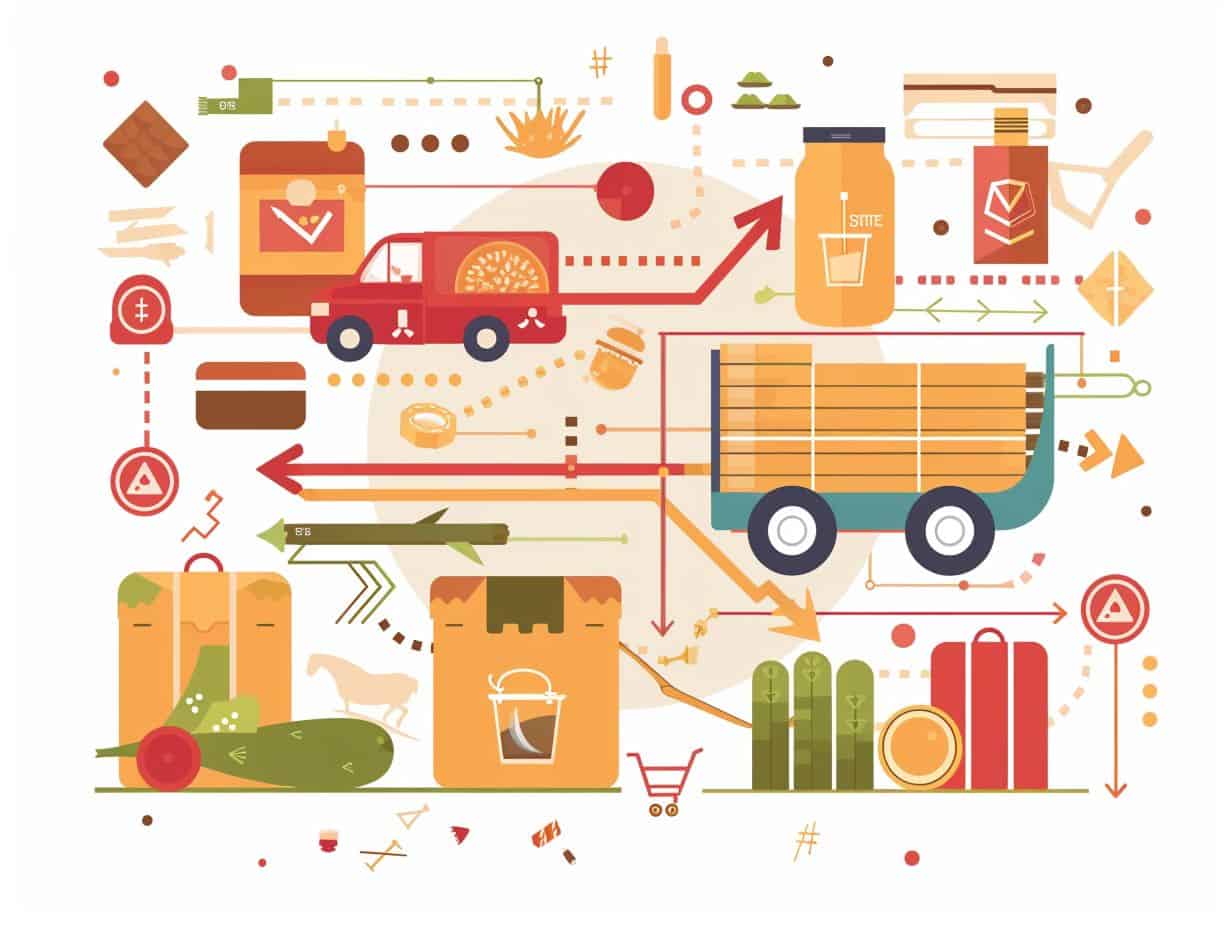In the current fast-paced environment, the significance of traceability and transparency in the food industry is crucial. From ensuring food safety to establishing consumer trust, the advantages are plentiful.
This article will delve into the primary methods, such as tracking ingredients from supplier to manufacturer and utilizing technology for real-time monitoring, on how traceability and transparency are attained in the MRE supply chain.
Challenges such as the absence of standardization and restricted resources need to be tackled. Solutions encompass collaboration, technological investments, and government regulations. Let’s further examine the realm of traceability and transparency in the MRE supply chain.
What are the Benefits of Traceability and Transparency?
Traceability and transparency in the food industry offer various advantages. They improve food safety by enabling the tracking of ingredients throughout the production process, ensuring adherence to food safety standards and regulations. These practices are crucial for enhancing quality control measures, allowing for better monitoring of the production process to uphold high standards of quality assurance.
Traceability and transparency play a significant role in establishing consumer trust, as customers appreciate understanding the origins and handling of the products they purchase.
These practices not only aid in preventing contamination and identifying the source of potential issues but also facilitate quick recalls in the event of safety concerns. By providing insight into the supply chain, businesses can promptly address any safety incidents, thereby protecting public health. Increased transparency promotes accountability, motivating food producers to uphold ethical practices and comply with sustainability guidelines, which align with the growing consumer demand for socially responsible products.
The integration of traceability and transparency is essential in laying a strong foundation for a reliable and sustainable food system.
1. Ensuring Food Safety
Ensuring food safety through traceability and transparency is crucial in the food industry. Implementing robust traceability systems and tracking technologies allows companies to effectively oversee the entire supply chain, from sourcing ingredients to production processes, reducing the risks of food contamination and ensuring adherence to strict food safety standards and regulations.
This approach not only aids in promptly identifying and recalling products in the event of issues but also fosters consumer trust. Adhering to regulations such as the Food Safety Modernization Act (FSMA) and Global Food Safety Initiative (GFSI) is vital for businesses to maintain the quality and safety of their products. Technology plays a significant role in achieving this level of traceability, with solutions like blockchain facilitating real-time monitoring and documentation of each stage in the food production cycle.
2. Improving Quality Control
Enhancing quality control is a significant advantage of incorporating traceability and transparency in the food supply chain. Effective traceability systems enable companies to improve inventory management, trace product origins, and establish audit trails to uphold the integrity of products across the production process.
This increased visibility within the supply chain supports the monitoring of raw material and finished goods movement, crucial for upholding quality standards. Complete traceability of a product’s journey, from ingredient sourcing to distribution to retailers, facilitates the identification and resolution of any issues that may arise. By integrating quality assurance procedures into traceability systems, companies can proactively manage potential risks and ensure products adhere to rigorous quality standards.
3. Building Consumer Trust
The food industry benefits from traceability and transparency by building consumer trust. Transparency in the supply chain, along with providing detailed information on ingredients and sourcing methods, helps to enhance consumer confidence and authenticity. This, in turn, strengthens relationships between brands and customers.
When consumers are given access to detailed information about how their products were produced, transported, and stored, it instills a sense of reassurance and reliability. This transparency fosters a direct connection between the consumer and the brand, leading to the consumer feeling valued and understood. Consequently, consumers are more inclined to trust the integrity of the products they purchase, resulting in increased loyalty and repeat business for the brand.
How is Traceability and Transparency Achieved in the MRE Supply Chain?
Achieving traceability and transparency in the MRE supply chain involves tracking ingredients from suppliers to manufacturers, utilizing technology for real-time monitoring, and implementing third-party audits. These processes ensure visibility, accountability, and authentication throughout the chain of custody.
By closely monitoring the flow of ingredients, companies can pinpoint the exact origins of each component, ensuring quality and compliance. Technology plays a vital role in this by providing real-time data on the sourcing, production, and distribution of materials. Integrating systems like RFID tags and blockchain technology enables the seamless tracking of goods at every stage. Third-party audits further validate these processes by independently verifying compliance with industry standards and regulations, fostering trust among stakeholders.
1. Tracking Ingredients from Supplier to Manufacturer

Tracking ingredients from suppliers to manufacturers is a critical aspect of ensuring traceability and transparency in the MRE supply chain. By meticulously documenting the journey of ingredients, companies can effectively manage their supply chain, verify ingredient sourcing practices, and uphold transparency standards.
This process begins with selecting reputable suppliers who adhere to strict quality and ethical standards. Once the ingredients are sourced, detailed records are maintained to track their movement through each stage of production. This meticulous monitoring ensures that ingredients meet regulatory requirements and quality specifications.
Effective supply chain management not only helps in identifying potential issues early on but also plays a significant role in maintaining consumer trust. By prioritizing transparent ingredient sourcing and robust supply chain practices, companies can strengthen their brand reputation and ensure the safety and quality of their products.
2. Utilizing Technology for Real-time Monitoring
The use of technology for real-time monitoring is essential for achieving traceability and transparency in the MRE supply chain. By incorporating advanced data management systems and real-time tracking technologies, companies can improve visibility, enhance decision-making processes, and ensure proactive risk management.
This integration of technology allows for accurate product tracking throughout the supply chain and provides stakeholders with real-time data on inventory levels, production processes, and transportation. This transparency builds trust among consumers, as they can easily trace the origins and journey of purchased products. The implementation of technology-driven solutions helps in identifying inefficiencies, reducing delays, and optimizing the overall performance of the supply chain.
3. Implementing Third-party Audits
Implementing third-party audits is a fundamental strategy for improving traceability and transparency in the MRE supply chain. By conducting comprehensive audits, companies can verify their processes, ensure adherence to standards, and efficiently manage vendor relationships to uphold integrity and accountability.
Audit trails resulting from these audits serve as documented proof of each stage in the supply chain, providing a systematic method to track the movement of materials and information. This not only assists in identifying potential risks or discrepancies but also facilitates prompt issue resolution and decision-making.
Effective vendor management, another critical element, guarantees that suppliers meet required criteria and uphold ethical standards, fostering a sustainable and responsible supply chain.
Compliance standards are essential in aligning operations with legal mandates, industry regulations, and best practices, safeguarding the company’s reputation and credibility.
What Challenges are Faced in Achieving Traceability and Transparency?
Several challenges are encountered in achieving traceability and transparency in the food industry. These challenges include issues like the lack of standardization, limited resources, and resistance to change, all of which can impede the implementation of effective traceability systems and adherence to regulatory requirements.
The intricate nature of supply chains amplifies the complexities of ensuring traceability, as products progress through various stages involving numerous stakeholders. The complexities of global sourcing, production, and distribution networks further complicate the tracking of products from farm to table. Compliance with constantly evolving regulations adds another layer of difficulty, necessitating ongoing monitoring and adaptation.
Risk management becomes crucial in mitigating potential threats such as contamination or food fraud, emphasizing the importance of robust traceability practices. Operational constraints, such as outdated technology or insufficient data management systems, present additional obstacles in establishing comprehensive traceability frameworks.
1. Lack of Standardization
The absence of standardization presents a significant challenge in achieving traceability and transparency within the food industry. Without consistent compliance standards and uniform inventory control practices, companies may face difficulties in maintaining precise and dependable traceability systems.
In an industry where accuracy and accountability are crucial, the lack of standardized processes can result in inconsistencies in product tracking and documentation. This inconsistency not only impedes the ability to promptly identify and resolve issues within the supply chain but also compromises consumer safety and trust.
Compliance standards play a vital role in establishing a framework for ensuring adherence to best practices by all stakeholders, fostering a culture of quality and dependability. Effective inventory control measures further improve visibility and prevent errors, allowing companies to streamline operations and reduce risks associated with recalls and contamination incidents.
2. Limited Resources

Limited resources pose a significant challenge to achieving traceability and transparency in the food supply chain. Companies may encounter difficulties in investing in advanced data management systems, establishing strong supplier relationships, and ensuring comprehensive traceability due to resource constraints.
This lack of resources can result in gaps in information sharing and coordination across the supply chain, impeding efforts to accurately track and trace products. Insufficient funding and manpower dedicated to data management may hinder companies from implementing real-time monitoring systems that offer essential insights into the origin and journey of food products.
Strained supplier relationships arising from resource limitations can impact the ability to collect reliable data and authenticate products, further complicating transparency initiatives.
3. Resistance to Change
Resistance to change presents a significant obstacle to the implementation of traceability and transparency initiatives in the food industry. Companies may face internal opposition to incorporating technology, making operational changes, and adopting new traceability practices, impeding progress towards improved transparency and accountability.
This resistance often arises from factors like fear of the unknown, lack of awareness regarding the benefits of traceability, and concerns about disruptions to current workflows. Overcoming this resistance involves not only persuading employees of the advantages of these changes but also ensuring that the organization is prepared to accept the necessary modifications.
By promoting a culture of adaptability and investing in training programs to enhance skill sets, companies can better address the challenges linked to implementing traceability and transparency measures.
What are the Solutions to Overcome These Challenges?
To address the challenges associated with achieving traceability and transparency, companies can adopt various solutions. These include fostering collaboration and communication among supply chain partners, investing in technology and training, and adhering to government regulations and incentives. These strategies have the potential to enhance visibility within the supply chain, improve data management practices, and cultivate a culture centered on compliance.
Establishing solid partnerships with suppliers and stakeholders to facilitate the exchange of information and best practices can assist organizations in constructing a network that encourages transparency and accountability across the supply chain. Incorporating advanced technologies like blockchain, IoT, and AI can streamline data collection and verification processes, ensuring accuracy and enabling real-time tracking. Additionally, keeping abreast of evolving regulatory requirements and obtaining relevant certifications can help companies showcase their dedication to ethical business conduct, earn consumer trust, and gain competitive advantages in the marketplace.
1. Collaboration and Communication Among Supply Chain Partners
Collaboration and communication among supply chain partners are fundamental strategies for addressing challenges in traceability and transparency. By fostering strong partnerships, sharing information, and integrating technology solutions, companies can improve supply chain visibility, enhance operational efficiency, and implement accountability measures.
This coordinated approach also facilitates the exchange of real-time data and insights, allowing partners to respond promptly to any disruptions or deviations in the supply chain. Through the adoption of technology integration, such as blockchain for secure data sharing and IoT devices for tracking product movement, stakeholders can achieve increased accuracy and visibility throughout the supply chain process.
By establishing effective communication channels, organizations can efficiently tackle traceability challenges, ensuring compliance with regulations and meeting consumer expectations for transparency and sustainability.
2. Investment in Technology and Training
Investing in technology and training is a proactive approach to overcoming challenges in traceability and transparency. By leveraging advanced data integration systems, adopting traceability software, and providing comprehensive training to staff, companies can enhance their capabilities in managing supply chain data and ensuring transparency.
This strategic investment allows organizations to streamline data collection, storage, and analysis, enabling real-time tracking of products across the supply chain. With the right technology in place, businesses can easily trace products back to their origins, conduct swift recalls if needed, and meet compliance standards. Continuous training ensures that employees are equipped to utilize these tools effectively, improving overall operational efficiency and customer trust.
Ultimately, the synergy between technology and training paves the way for a more transparent and secure supply chain ecosystem.
3. Government Regulations and Incentives

Government regulations and incentives are essential in addressing challenges related to traceability and transparency. By adhering to regulatory requirements, meeting food safety standards, and utilizing government incentives for technology adoption, organizations can navigate intricate compliance landscapes and improve supply chain resilience.
This alignment with regulations not only ensures consumer trust in product safety and authenticity but also reinforces industry-wide standards. Government incentives, like tax incentives for implementing traceability systems, encourage businesses to adopt transparent practices.
Through regulatory alignment and compliance, organizations can enhance their reputation, reduce the risks of fraud or contamination, and build trust with stakeholders. By actively participating with regulators and industry peers, companies can stay abreast of evolving compliance frameworks and promote innovation in traceability solutions.
Frequently Asked Questions
What is traceability in the MRE supply chain?
Traceability refers to the ability to track the movement of ingredients and products through the MRE supply chain. It allows for the identification of the source, location, and movement of ingredients, providing transparency and accountability in the supply chain.
Why is traceability important in the MRE supply chain?
Traceability is important for several reasons. It allows for the identification of potential food safety issues, helps with quality control, and ensures compliance with regulations. It also provides consumers with information about the origin and production of their food, promoting trust and transparency.
What methods are used to trace ingredients in the MRE supply chain?
There are various methods used to trace ingredients in the MRE supply chain, including barcoding, RFID technology, and blockchain. These methods use unique identifiers to track the movement of ingredients from the source to the final product, providing visibility and transparency.
How does traceability impact food safety in the MRE supply chain?
Traceability plays a crucial role in ensuring food safety in the MRE supply chain. With the ability to track ingredients, any potential issues or contamination can be identified and contained quickly, preventing widespread health risks. This also allows for more efficient recalls if necessary.
Are there regulations in place for traceability in the MRE supply chain?
Yes, there are regulations in place to ensure traceability in the MRE supply chain. These regulations vary by country, but they all aim to promote food safety, quality control, and transparency. In the United States, the Food Safety Modernization Act (FSMA) requires companies to have a system in place for tracking and tracing ingredients.
How does traceability benefit the consumer?
Traceability benefits the consumer in several ways. It provides them with information about the origin and production of their food, allowing them to make more informed choices. It also promotes trust and confidence in the supply chain, as consumers can have a better understanding of the safety and quality measures in place for their food.


